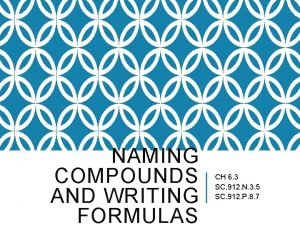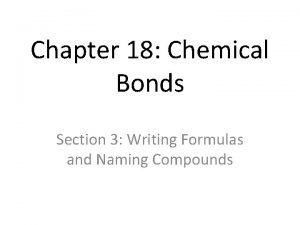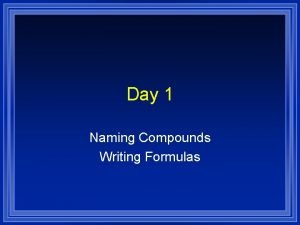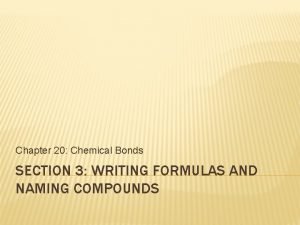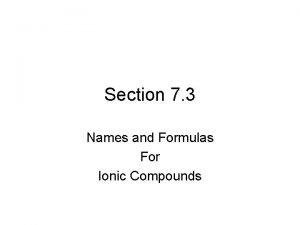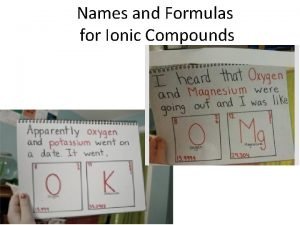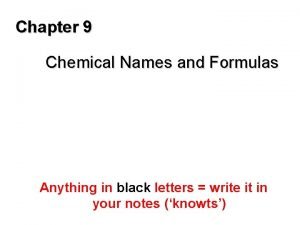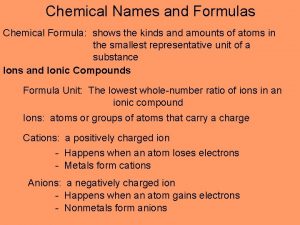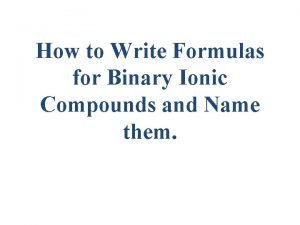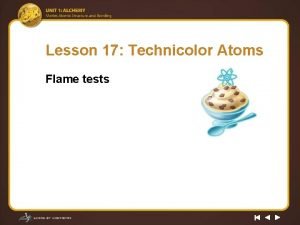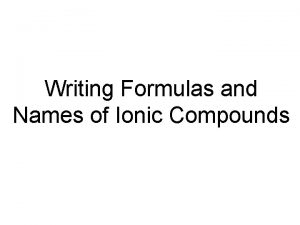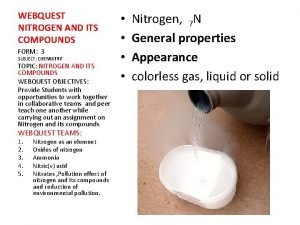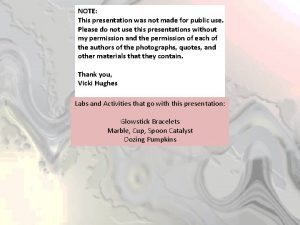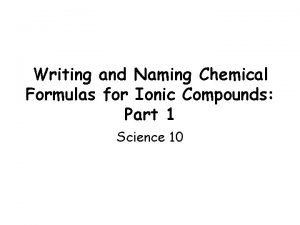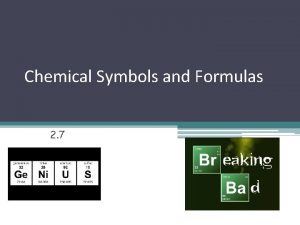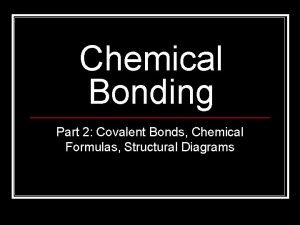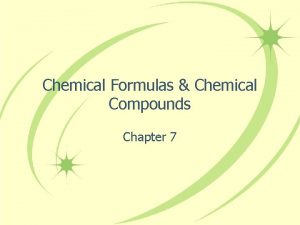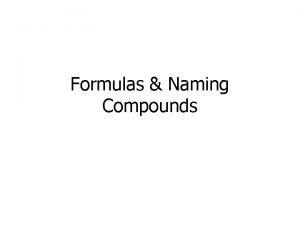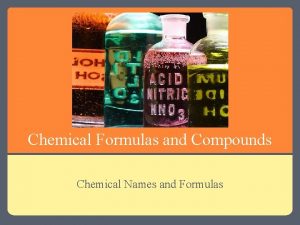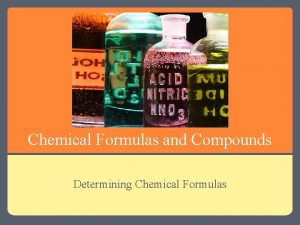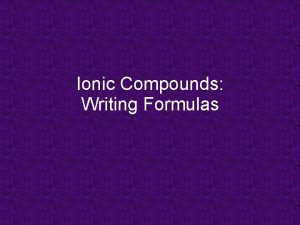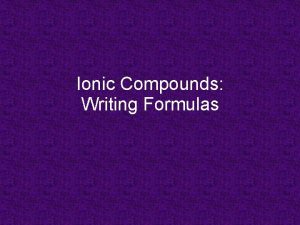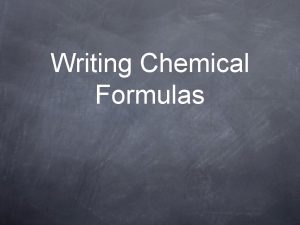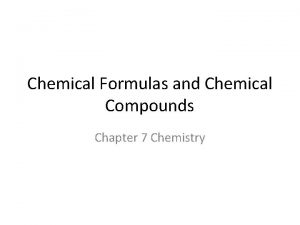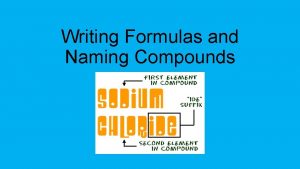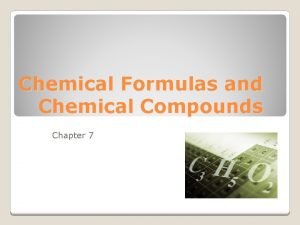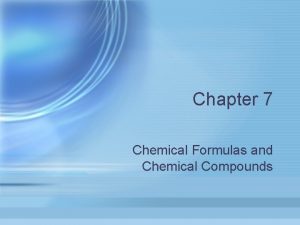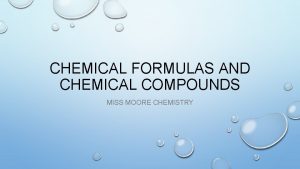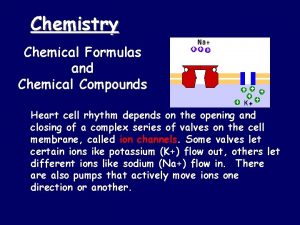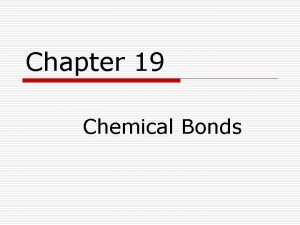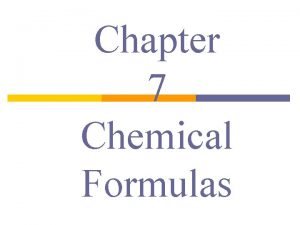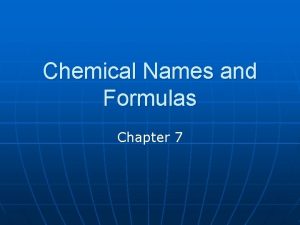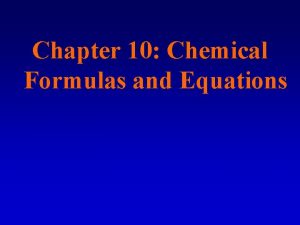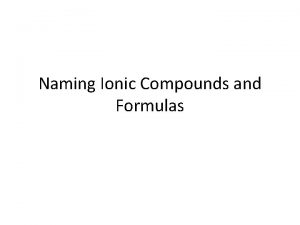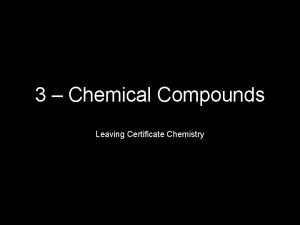Chemistry Chapter 7 Chemical Formulas and Chemical Compounds


































- Slides: 34

Chemistry Chapter 7 Chemical Formulas and Chemical Compounds Heart cell rhythm depends on the opening and closing of a complex series of valves on the cell membrane, called ion channels. Some valves let certain ions ike potassium (K+) flow out, others let different ions like sodium (Na+) flow in. There also pumps that actively move ions one direction or another.

Ions • Cation: A positive ion • Mg 2+, NH 4+ • Anion: A negative ion • Cl-, SO 42 • Ionic Bonding: Force of attraction between oppositely charged ions.

Predicting Ionic Charges Group 1: Lose 1 electron to form 1+ ions H+ Li+ Na+ K+

Predicting Ionic Charges Group 2: Loses 2 electrons to form 2+ ions Be 2+ Mg 2+ Ca 2+ Sr 2+ Ba 2+

Predicting Ionic Charges B 3+ Al 3+ Ga 3+ Group 13: Loses 3 electrons to form 3+ ions

Predicting Ionic Charges Neither! Group 13 elements rarely form ions. Group 14: Lose 4 electrons or gain 4 electrons?

Predicting Ionic Charges N 3 - Nitride P 3 - Phosphide As 3 - Arsenide Group 15: Gains 3 electrons to form 3 - ions

Predicting Ionic Charges O 2 - Oxide S 2 - Sulfide Se 2 - Selenide Group 16: Gains 2 electrons to form 2 - ions

Predicting Ionic Charges F 1 - Fluoride Br 1 - Bromide Cl 1 -Chloride I 1 - Iodide Group 17: Gains 1 electron to form 1 - ions

Predicting Ionic Charges Group 18: Stable Noble gases do not form ions!

Predicting Ionic Charges Groups 3 - 12: Many transition elements have more than one possible oxidation state. Iron(II) = Fe 2+ Iron(III) = Fe 3+

Predicting Ionic Charges Groups 3 - 12: Some transition elements have only one possible oxidation state. Zinc = Zn 2+ Silver = Ag+

Writing Ionic Compound Formulas Example: Barium nitrate 1. Write the formulas for the cation and anion, including CHARGES! 2. Check to see if charges are balanced. 2+ ( Ba NO 3 ) 2 3. Balance charges , if necessary, using subscripts. Use parentheses if you need more than one of a polyatomic ion. Not balanced!

Writing Ionic Compound Formulas Example: Ammonium sulfate 1. Write the formulas for the cation and anion, including CHARGES! 2. Check to see if charges are balanced. ( NH 4+) SO 42 - 3. Balance charges , if necessary, using subscripts. Use parentheses if you need more than one of a polyatomic ion. 2 Not balanced!

Writing Ionic Compound Formulas Example: Iron(III) chloride 1. Write the formulas for the cation and anion, including CHARGES! 2. Check to see if charges are balanced. 3. Balance charges , if necessary, using subscripts. Use parentheses if you need more than one of a polyatomic ion. Fe 3+ Cl 3 3 Not balanced!

Writing Ionic Compound Formulas Example: Aluminum sulfide 1. Write the formulas for the cation and anion, including CHARGES! 2. Check to see if charges are balanced. 3. Balance charges , if necessary, using subscripts. Use parentheses if you need more than one of a polyatomic ion. 3+ Al 2 2 S 3 Not balanced!

Writing Ionic Compound Formulas Example: Magnesium carbonate 1. Write the formulas for the cation and anion, including CHARGES! 2. Check to see if charges are balanced. Mg 2+ CO 32 They are balanced!

Writing Ionic Compound Formulas Example: Zinc hydroxide 1. Write the formulas for the cation and anion, including CHARGES! 2. Check to see if charges are balanced. 2+ ( Zn OH ) 3. Balance charges , if necessary, using subscripts. Use parentheses if you need more than one of a polyatomic ion. 2 Not balanced!

Writing Ionic Compound Formulas Example: Aluminum phosphate 1. Write the formulas for the cation and anion, including CHARGES! 2. Check to see if charges are balanced. 3+ Al 3 PO 4 They ARE balanced!

Naming Ionic Compounds • 1. Cation first, then anion • 2. Monatomic cation = name of the element • Ca 2+ = calcium ion • 3. Monatomic anion = root + -ide • Cl- = chloride • Ca. Cl 2 = calcium chloride

Naming Ionic Compounds (continued) Metals with multiple oxidation states some metal forms more than one cation • - use Roman numeral in name • - • Pb. Cl 2 • Pb 2+ is cation • Pb. Cl 2 = lead(II) chloride

Naming Binary Compounds • - • • - Compounds between two nonmetals First element in the formula is named first. Second element is named as if it were an anion. Use prefixes Only use mono on second element P 2 O 5 CO 2 CO N 2 O = diphosphorus pentoxide = carbon dioxide = carbon monoxide = dinitrogen monoxide

Calculating Formula Mass Calculate the formula mass of magnesium carbonate, Mg. CO 3. 24. 31 g + 12. 01 g + 3(16. 00 g) = 84. 32 g

Calculating Percentage Composition Calculate the percentage composition of magnesium carbonate, Mg. CO 3. From previous slide: 24. 31 g + 12. 01 g + 3(16. 00 g) = 84. 32 g 100. 00

Formulas Empirical formula: the lowest whole number ratio of atoms in a compound. Molecular formula: the true number of atoms of each element in the formula of a compound. q molecular formula = (empirical formula)n [n = integer] q molecular formula = C 6 H 6 = (CH)6 q empirical formula = CH

Formulas (continued) Formulas for ionic compounds are ALWAYS empirical (lowest whole number ratio). Examples: Na. Cl Mg. Cl 2 Al 2(SO 4)3 K 2 CO 3

Formulas (continued) Formulas for molecular compounds MIGHT be empirical (lowest whole number ratio). Molecular: H 2 O C 6 H 12 O 6 C 12 H 22 O 11 Empirical: H 2 O CH 2 O C 12 H 22 O 11

Empirical Formula Determination 1. Base calculation on 100 grams of compound. 2. Determine moles of each element in 100 grams of compound. 3. Divide each value of moles by the smallest of the values. 4. Multiply each number by an integer to obtain all whole numbers.

Empirical Formula Determination Adipic acid contains 49. 32% C, 43. 84% O, and 6. 85% H by mass. What is the empirical formula of adipic acid?

Empirical Formula Determination (part 2) Divide each value of moles by the smallest of the values. Carbon: Hydrogen: Oxygen:

Empirical Formula Determination (part 3) Multiply each number by an integer to obtain all whole numbers. Carbon: 1. 50 x 2 3 Hydrogen: 2. 50 x 2 5 Oxygen: 1. 00 x 2 2 Empirical formula: C 3 H 5 O 2

Finding the Molecular Formula The empirical formula for adipic acid is C 3 H 5 O 2. The molecular mass of adipic acid is 146 g/mol. What is the molecular formula of adipic acid? 1. Find the formula mass of C 3 H 5 O 2 3(12. 01 g) + 5(1. 01) + 2(16. 00) = 73. 08 g

Finding the Molecular Formula The empirical formula for adipic acid is C 3 H 5 O 2. The molecular mass of adipic acid is 146 g/mol. What is the molecular formula of adipic acid? 2. Divide the molecular mass by the mass given by the emipirical formula. 3(12. 01 g) + 5(1. 01) + 2(16. 00) = 73. 08 g

Finding the Molecular Formula The empirical formula for adipic acid is C 3 H 5 O 2. The molecular mass of adipic acid is 146 g/mol. What is the molecular formula of adipic acid? 3. Multiply the empirical formula by this number to get the molecular formula. 3(12. 01 g) + 5(1. 01) + 2(16. 00) = 73. 08 g (C 3 H 5 O 2) x 2 = C 6 H 10 O 4
 Chapter 7 chemical formulas and chemical compounds test
Chapter 7 chemical formulas and chemical compounds test Modern chemistry chapter 7 test
Modern chemistry chapter 7 test Chapter 9 chemical names and formulas answer key
Chapter 9 chemical names and formulas answer key Naming chemical compounds
Naming chemical compounds Chemical names and formulas chapter 9
Chemical names and formulas chapter 9 Covalent and ionic venn diagram
Covalent and ionic venn diagram Naming and writing formulas for molecular compounds
Naming and writing formulas for molecular compounds Section 3 writing formulas and naming compounds answer key
Section 3 writing formulas and naming compounds answer key Monatomic ion
Monatomic ion Tetraiodine nonaoxide formula
Tetraiodine nonaoxide formula Section 3 writing formulas and naming compounds
Section 3 writing formulas and naming compounds Section 3 names and formulas for ionic compounds
Section 3 names and formulas for ionic compounds Section 3 names and formulas for ionic compounds
Section 3 names and formulas for ionic compounds Writing formulas criss-cross method worksheet
Writing formulas criss-cross method worksheet Chemical names and formulas
Chemical names and formulas Binary compound
Binary compound Which two formulas represent compounds
Which two formulas represent compounds Lesson 21 salty eights formulas for ionic compounds answers
Lesson 21 salty eights formulas for ionic compounds answers Writing formulas for ionic compounds worksheet
Writing formulas for ionic compounds worksheet Klb chemistry book 3 nitrogen and its compounds
Klb chemistry book 3 nitrogen and its compounds Chemistry chapter 8 review chemical equations and reactions
Chemistry chapter 8 review chemical equations and reactions Properties of ionic bonds
Properties of ionic bonds Chemistry chapter 7 ionic and metallic bonding
Chemistry chapter 7 ionic and metallic bonding Meth eth but prop
Meth eth but prop Naming of organic compounds
Naming of organic compounds Condensed structure of cyclohexane
Condensed structure of cyclohexane Name and symbols of some ions
Name and symbols of some ions Chemistry chapter 10 chemical quantities
Chemistry chapter 10 chemical quantities In an ionic compound the chemical formula represents
In an ionic compound the chemical formula represents Chemical symbol and formula
Chemical symbol and formula Mole forumla
Mole forumla Covalent bond formula
Covalent bond formula Criss-cross method chemistry worksheet
Criss-cross method chemistry worksheet Ionic compounds review
Ionic compounds review Unit chemical bonding forming ionic compounds ws 2
Unit chemical bonding forming ionic compounds ws 2






